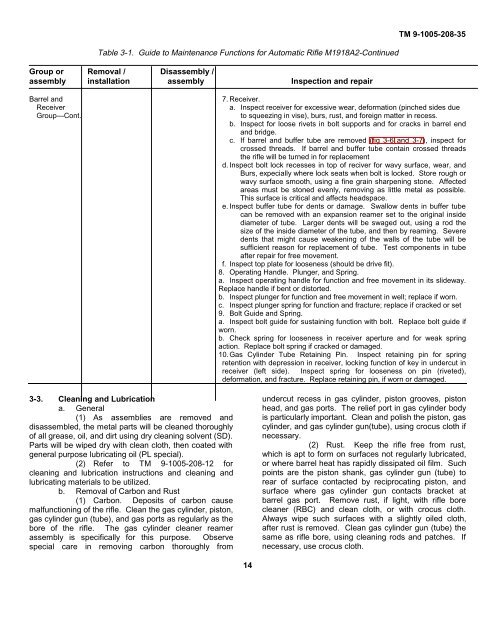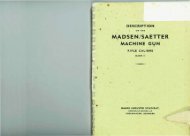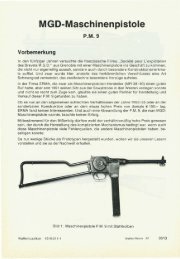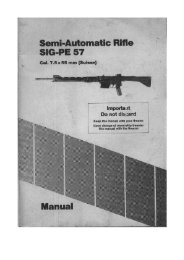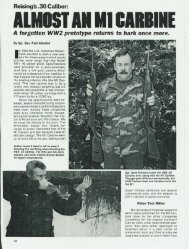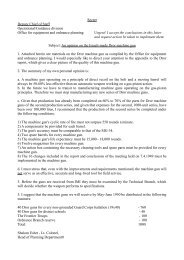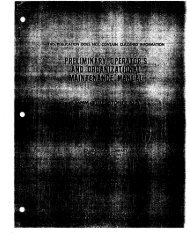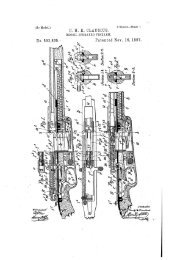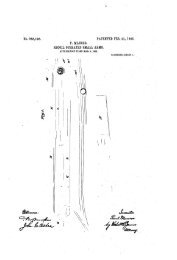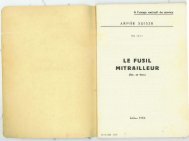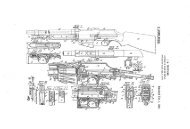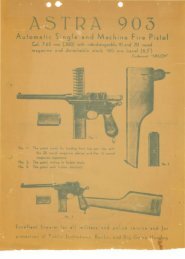TM 9-1005-208-35 M1918A2 BAR.pdf - Forgotten Weapons
TM 9-1005-208-35 M1918A2 BAR.pdf - Forgotten Weapons
TM 9-1005-208-35 M1918A2 BAR.pdf - Forgotten Weapons
Create successful ePaper yourself
Turn your PDF publications into a flip-book with our unique Google optimized e-Paper software.
Table 3-1. Guide to Maintenance Functions for Automatic Rifle <strong>M1918A2</strong>-Continued<br />
Group or Removal / Disassembly /<br />
assembly installation assembly Inspection and repair<br />
<strong>TM</strong> 9-<strong>1005</strong>-<strong>208</strong>-<strong>35</strong><br />
Barrel and 7. Receiver.<br />
Receiver a. Inspect receiver for excessive wear, deformation (pinched sides due<br />
Group—Cont. to squeezing in vise), burs, rust, and foreign matter in recess.<br />
b. Inspect for loose rivets in bolt supports and for cracks in barrel end<br />
and bridge.<br />
c. If barrel and buffer tube are removed (fig 3-6 and 3-7), inspect for<br />
crossed threads. If barrel and buffer tube contain crossed threads<br />
the rifle will be turned in for replacement<br />
d. Inspect bolt lock recesses in top of reciver for wavy surface, wear, and<br />
Burs, expecially where lock seats when bolt is locked. Store rough or<br />
wavy surface smooth, using a fine grain sharpening stone. Affected<br />
areas must be stoned evenly, removing as little metal as possible.<br />
This surface is critical and affects headspace.<br />
e. Inspect buffer tube for dents or damage. Swallow dents in buffer tube<br />
can be removed with an expansion reamer set to the original inside<br />
diameter of tube. Larger dents will be swaged out, using a rod the<br />
size of the inside diameter of the tube, and then by reaming. Severe<br />
dents that might cause weakening of the walls of the tube will be<br />
sufficient reason for replacement of tube. Test components in tube<br />
after repair for free movement.<br />
f. Inspect top plate for looseness (should be drive fit).<br />
8. Operating Handle. Plunger, and Spring.<br />
a. Inspect operating handle for function and free movement in its slideway.<br />
Replace handle if bent or distorted.<br />
b. Inspect plunger for function and free movement in well; replace if worn.<br />
c. Inspect plunger spring for function and fracture; replace if cracked or set<br />
9. Bolt Guide and Spring.<br />
a. Inspect bolt guide for sustaining function with bolt. Replace bolt guide if<br />
worn.<br />
b. Check spring for looseness in receiver aperture and for weak spring<br />
action. Replace bolt spring if cracked or damaged.<br />
10.Gas Cylinder Tube Retaining Pin. Inspect retaining pin for spring<br />
retention with depression in receiver, locking function of key in undercut in<br />
receiver (left side). Inspect spring for looseness on pin (riveted),<br />
deformation, and fracture. Replace retaining pin, if worn or damaged.<br />
3-3. Cleaning and Lubrication<br />
a. General<br />
(1) As assemblies are removed and<br />
disassembled, the metal parts will be cleaned thoroughly<br />
of all grease, oil, and dirt using dry cleaning solvent (SD).<br />
Parts will be wiped dry with clean cloth, then coated with<br />
general purpose lubricating oil (PL special).<br />
(2) Refer to <strong>TM</strong> 9-<strong>1005</strong>-<strong>208</strong>-12 for<br />
cleaning and lubrication instructions and cleaning and<br />
lubricating materials to be utilized.<br />
b. Removal of Carbon and Rust<br />
(1) Carbon. Deposits of carbon cause<br />
malfunctioning of the rifle. Clean the gas cylinder, piston,<br />
gas cylinder gun (tube), and gas ports as regularly as the<br />
bore of the rifle. The gas cylinder cleaner reamer<br />
assembly is specifically for this purpose. Observe<br />
special care in removing carbon thoroughly from<br />
14<br />
undercut recess in gas cylinder, piston grooves, piston<br />
head, and gas ports. The relief port in gas cylinder body<br />
is particularly important. Clean and polish the piston, gas<br />
cylinder, and gas cylinder gun(tube), using crocus cloth if<br />
necessary.<br />
(2) Rust. Keep the rifle free from rust,<br />
which is apt to form on surfaces not regularly lubricated,<br />
or where barrel heat has rapidly dissipated oil film. Such<br />
points are the piston shank, gas cylinder gun (tube) to<br />
rear of surface contacted by reciprocating piston, and<br />
surface where gas cylinder gun contacts bracket at<br />
barrel gas port. Remove rust, if light, with rifle bore<br />
cleaner (RBC) and clean cloth, or with crocus cloth.<br />
Always wipe such surfaces with a slightly oiled cloth,<br />
after rust is removed. Clean gas cylinder gun (tube) the<br />
same as rifle bore, using cleaning rods and patches. If<br />
necessary, use crocus cloth.


